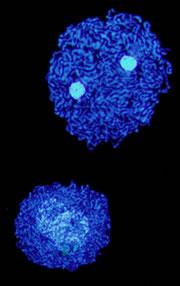 Carsonella ruddii and its tiny genome piggyback on other creatures to survive.
Carsonella ruddii and its tiny genome piggyback on other creatures to survive.How small can a genome get and still run a living organism? Researchers now say that a symbiotic bacterium called Carsonella ruddii, which lives off sap-feeding insects, has taken the record for smallest genome with just 159,662 'letters' (or base pairs) of DNA and 182 protein-coding genes. At one-third the size of previously found 'minimal' organisms, it is smaller than researchers thought they would find.
At the same time, a second group reports another bacterium, Buchnera aphidicola, also with a surprisingly small genome — at just over 400,000 base pairs of DNA it's little more than twice the size of C. ruddii's, but again smaller than anything seen previously. The human genome, by comparison, has 3 billion base pairs.
The discoveries, reported today in Science1,2, suggest that only a remarkably small collection of molecular parts is needed to make up a viable life form. It's rather as if a computer can be put together from just a handful of transistors.
This is encouraging news for synthetic biologists who are hoping to make designer bacteria from scratch, which could perform useful functions such as synthesizing pharmaceuticals or fuels.
Amparo Latorre of the University of Valencia, Spain, who co-authored the B. aphidicola work, says the genomes of both these symbionts are small enough to be made by today's DNA-synthesis technology.
But researchers warn that the natural streamlined bacteria are both symbionts, dependent on their host organisms for certain functions or nutrients that they can't provide themselves. "They can't be grown on their own," says Latorre.
Do-it-yourself
Geneticist Craig Venter, head of the J. Craig Venter Institute in Rockville, Maryland, is hoping that small-genome organisms will point the way to a minimal genome: the smallest possible set of genetic parts needed to generate life, from which an organism might then be designed and built. One of Venter's goals is a synthetic bacterium that makes fuels such as hydrogen from renewable raw materials.
When Venter announced plans to synthesize a working genome from scratch in 2002, his team estimated that one well-studied bacterium needed at least 300 or so of its genes to survive (see 'Venter aims for maximum impact with minimal genome').
But estimates have been getting smaller. A review published in Nature Molecular Systems Biology this year3 posited a hypothetical minimal genome of 113,000 base pairs and 151 genes — rather close to the new find.
Bare necessities
It is generally thought that a minimal genome will need to include genes for replication and for protein synthesis, and probably also for making the enzymes needed to construct basic building blocks, such as amino acids, from chemicals available in the immediate environment.
B. aphidicola challenges that idea, because it lacks the genes needed to make the essential amino acid tryptophan. Since the aphid hosts can't make this amino acid either, where does it come from? Latorre and her colleagues think it is supplied by a secondary symbiotic bacterium, showing just how interdependent these groups of organisms may become.
"The work shows that all discussions of minimal genomes have to think about the environment in which the organism will live," says Siv Andersson, an evolutionary molecular biologist at the University of Uppsala in Sweden.
C. ruddii seems even more extreme. "Its gene inventory seems insufficient for most biological processes that appear to be essential for bacterial life," write Atsushi Nakabachi at the University of Arizona in Tucson, Masahira Hattori at the University of Tokyo, Japan, and their colleagues. At the moment, the researchers are not sure how C. ruddii copes, although they speculate that some of the necessary genes may have been transferred over evolutionary time to the genomes of the host.
ADVERTISEMENT
That is precisely what is thought to have happened during the evolution of the compartments called mitochondria in our own cells, which are responsible for energy production. These are believed to have once been symbionts that lost all autonomy by relinquishing most of their genes to the host (mitochondria still have their own DNA).
Andersson says that C. ruddii might be analogues of mitochondria, caught in the process of changing from separate but dependent organisms into structures that will be engulfed and incorporated into the host cells.
Visit our genomeclocksinat_1.html">newsblog to read and post comments about this story.
-
References
- Nakabachi A., et al. Science, 314 . 267 (2006).
- Pérez-Brocal V., et al. Science, 314 . 312 - 313 (2006).
- Forster A. C., et al. Nature Mol. Syst. Biol., 2 . doi:10.1038/msb4100090 (2006).
